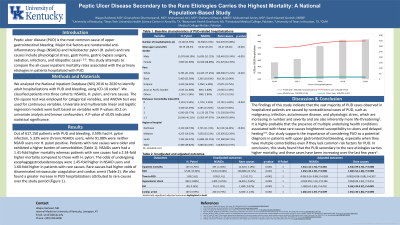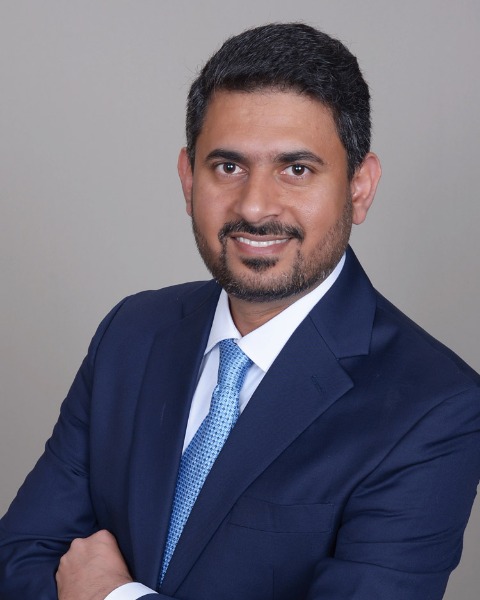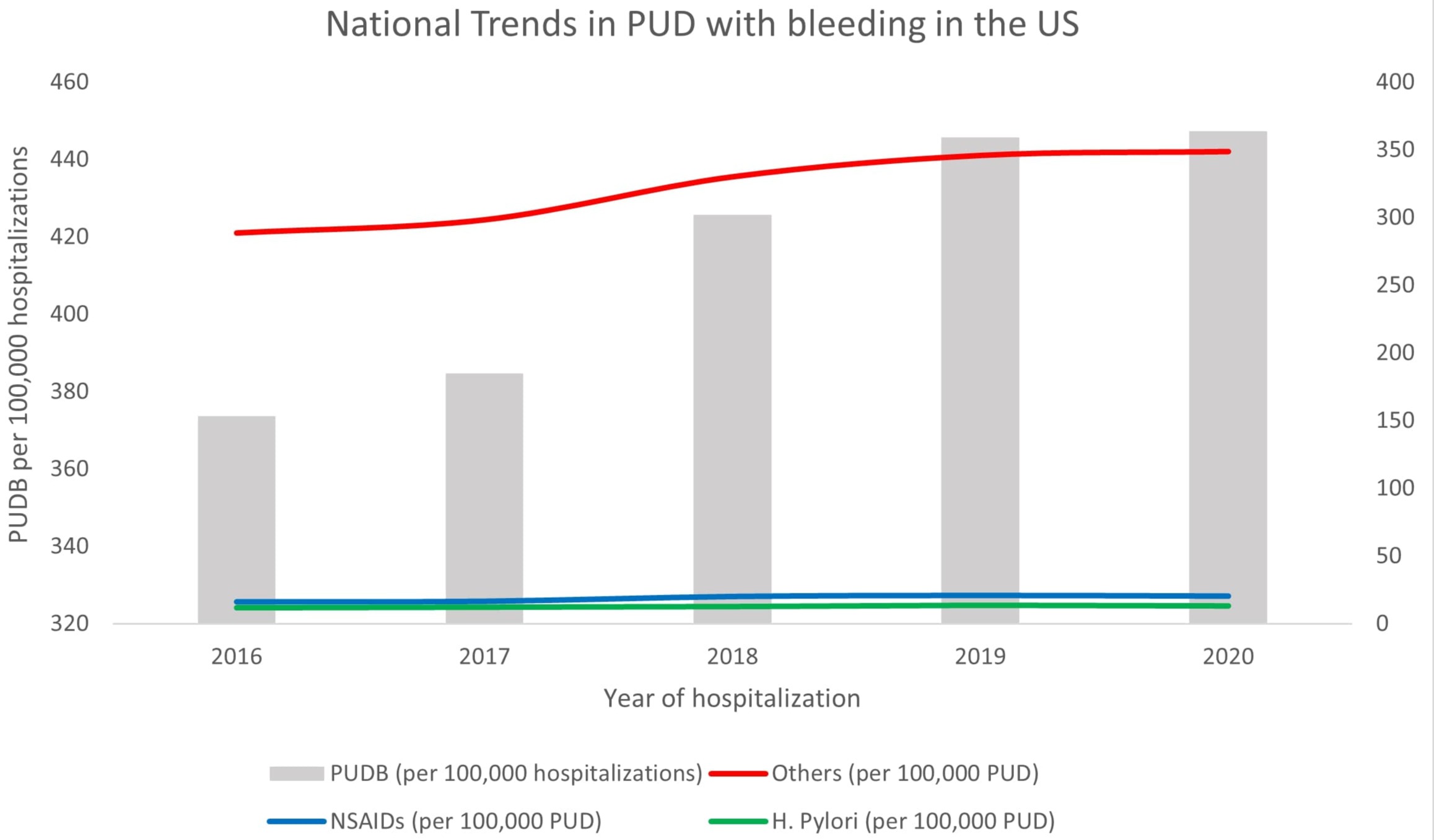Tuesday Poster Session
Category: GI Bleeding
P3447 - Peptic Ulcer Disease Secondary to the Rare Etiologies Carries the Highest Mortality: A National Population-Based Study
Tuesday, October 24, 2023
10:30 AM - 4:00 PM PT
Location: Exhibit Hall

Has Audio

Waqas Rasheed, MD
Texas Tech University Health Sciences Center
Lexington, KY
Presenting Author(s)
Waqas Rasheed, MD1, Gnanashree Dharmarpandi, MD1, Muhammad Anil, MD2, Shahana ishfaque, MBBS3, Muhammad Anees, MD1, Sarah Naveed. Qureshi, MBBS4
1Texas Tech University Health Sciences Center, Amarillo, TX; 2Beaumont Hospital, Dearborn, MI; 3Punjab Medical College, Faisalabad, Pakistan, Dearborn, MI; 4CMH Multan Institute of Medical Sciences, Multan, Pakistan, Beaumont, TX
Introduction: Peptic ulcer disease (PUD) is the most common cause of upper gastrointestinal bleeding. Major risk factors are nonsteroidal anti-inflammatory drugs (NSAIDs) and Helicobacter pylori (H. pylori) and rare causes include physiological stress, gastrinomas, gastric-bypass surgery, radiation, infections, and idiopathic cases. This study attempts to compare the all-cause mortality rates associated with the primary etiologies in patients hospitalized with PUD.
Methods: We analyzed the National Inpatient Database (NIS) 2016 to 2020 to identify adult patients with PUD and bleeding, using ICD-10 codes. We classified patients into three cohorts: NSAIDs, H. pylori, and rare causes. The Chi-square test was employed for categorical variables, while the ANOVA test was used for continuous variables. Univariate and multivariate linear and logistic regression models were built, considering variables with P-values ≤0.2 from univariate analysis and known confounders. A P-value of ≤0.05 indicated statistical significance.
Results: Out of 617,150 patients with PUD and bleeding, 3.59% had H. pylori infection, 5.33% were chronic NSAIDs users, while 91.08% were neither NSAID users nor H. pylori positive. Patients with rare causes were older and exhibited a higher burden of comorbidities. NSAIDs users had a 1.41-fold higher mortality whereas patients with rare causes had a 2.34-fold higher mortality compared to those with H. pylori. The odds of undergoing esophagogastroduodenoscopy were 1.45-fold higher in NSAID users and 1.60-fold higher in patients with rare causes. Rare causes had higher odds of disseminated intravascular coagulation and cardiac arrest (Table 1). We also found a greater increase in PUD hospitalizations attributed to rare causes over the study period (Figure 1).
Discussion: The findings of this study indicate that the vast majority of PUD cases observed in hospitalized patients are caused by nontraditional cases of PUD, such as malignancy, infection, autoimmune disease, and physiologic stress, which are increasing in number and severity and are also inherently more life-threatening. It is highly probable that the presence of multiple underlying health conditions associated with these rare causes heightened susceptibility to ulcers and delayed healing. Therefore, our study supports the importance of considering PUD as a potential diagnosis in patients with upper gastrointestinal symptoms, especially when they have multiple comorbidities and lack risk factors for traditional PUD.

Disclosures:
Waqas Rasheed, MD1, Gnanashree Dharmarpandi, MD1, Muhammad Anil, MD2, Shahana ishfaque, MBBS3, Muhammad Anees, MD1, Sarah Naveed. Qureshi, MBBS4. P3447 - Peptic Ulcer Disease Secondary to the Rare Etiologies Carries the Highest Mortality: A National Population-Based Study, ACG 2023 Annual Scientific Meeting Abstracts. Vancouver, BC, Canada: American College of Gastroenterology.
1Texas Tech University Health Sciences Center, Amarillo, TX; 2Beaumont Hospital, Dearborn, MI; 3Punjab Medical College, Faisalabad, Pakistan, Dearborn, MI; 4CMH Multan Institute of Medical Sciences, Multan, Pakistan, Beaumont, TX
Introduction: Peptic ulcer disease (PUD) is the most common cause of upper gastrointestinal bleeding. Major risk factors are nonsteroidal anti-inflammatory drugs (NSAIDs) and Helicobacter pylori (H. pylori) and rare causes include physiological stress, gastrinomas, gastric-bypass surgery, radiation, infections, and idiopathic cases. This study attempts to compare the all-cause mortality rates associated with the primary etiologies in patients hospitalized with PUD.
Methods: We analyzed the National Inpatient Database (NIS) 2016 to 2020 to identify adult patients with PUD and bleeding, using ICD-10 codes. We classified patients into three cohorts: NSAIDs, H. pylori, and rare causes. The Chi-square test was employed for categorical variables, while the ANOVA test was used for continuous variables. Univariate and multivariate linear and logistic regression models were built, considering variables with P-values ≤0.2 from univariate analysis and known confounders. A P-value of ≤0.05 indicated statistical significance.
Results: Out of 617,150 patients with PUD and bleeding, 3.59% had H. pylori infection, 5.33% were chronic NSAIDs users, while 91.08% were neither NSAID users nor H. pylori positive. Patients with rare causes were older and exhibited a higher burden of comorbidities. NSAIDs users had a 1.41-fold higher mortality whereas patients with rare causes had a 2.34-fold higher mortality compared to those with H. pylori. The odds of undergoing esophagogastroduodenoscopy were 1.45-fold higher in NSAID users and 1.60-fold higher in patients with rare causes. Rare causes had higher odds of disseminated intravascular coagulation and cardiac arrest (Table 1). We also found a greater increase in PUD hospitalizations attributed to rare causes over the study period (Figure 1).
Discussion: The findings of this study indicate that the vast majority of PUD cases observed in hospitalized patients are caused by nontraditional cases of PUD, such as malignancy, infection, autoimmune disease, and physiologic stress, which are increasing in number and severity and are also inherently more life-threatening. It is highly probable that the presence of multiple underlying health conditions associated with these rare causes heightened susceptibility to ulcers and delayed healing. Therefore, our study supports the importance of considering PUD as a potential diagnosis in patients with upper gastrointestinal symptoms, especially when they have multiple comorbidities and lack risk factors for traditional PUD.

Figure: Figure 1. National trends in PUD with bleeding related hospitalizations in the US 2016-2020
Disclosures:
Waqas Rasheed indicated no relevant financial relationships.
Gnanashree Dharmarpandi indicated no relevant financial relationships.
Muhammad Anil indicated no relevant financial relationships.
Shahana ishfaque indicated no relevant financial relationships.
Muhammad Anees indicated no relevant financial relationships.
Sarah Qureshi indicated no relevant financial relationships.
Waqas Rasheed, MD1, Gnanashree Dharmarpandi, MD1, Muhammad Anil, MD2, Shahana ishfaque, MBBS3, Muhammad Anees, MD1, Sarah Naveed. Qureshi, MBBS4. P3447 - Peptic Ulcer Disease Secondary to the Rare Etiologies Carries the Highest Mortality: A National Population-Based Study, ACG 2023 Annual Scientific Meeting Abstracts. Vancouver, BC, Canada: American College of Gastroenterology.
